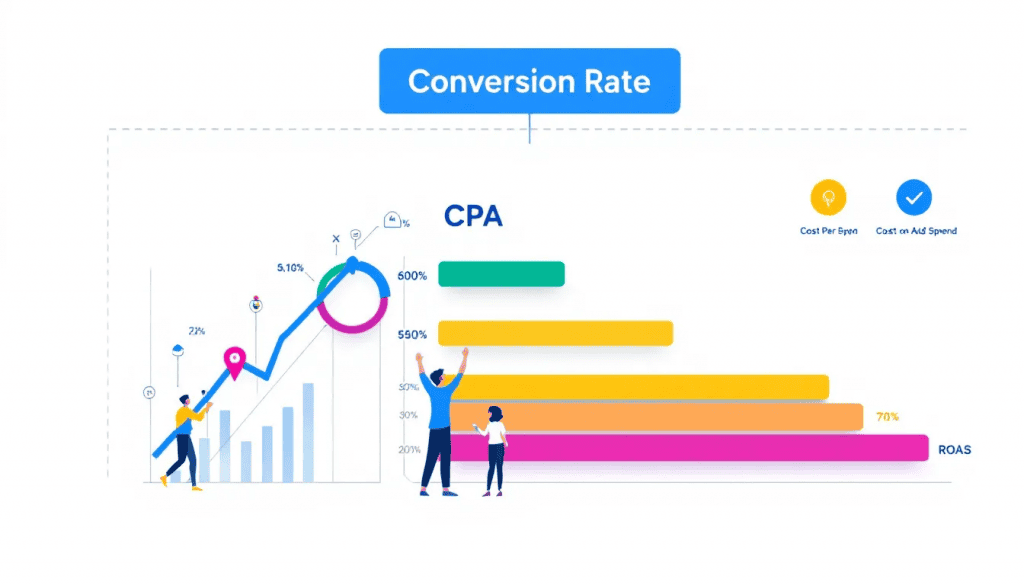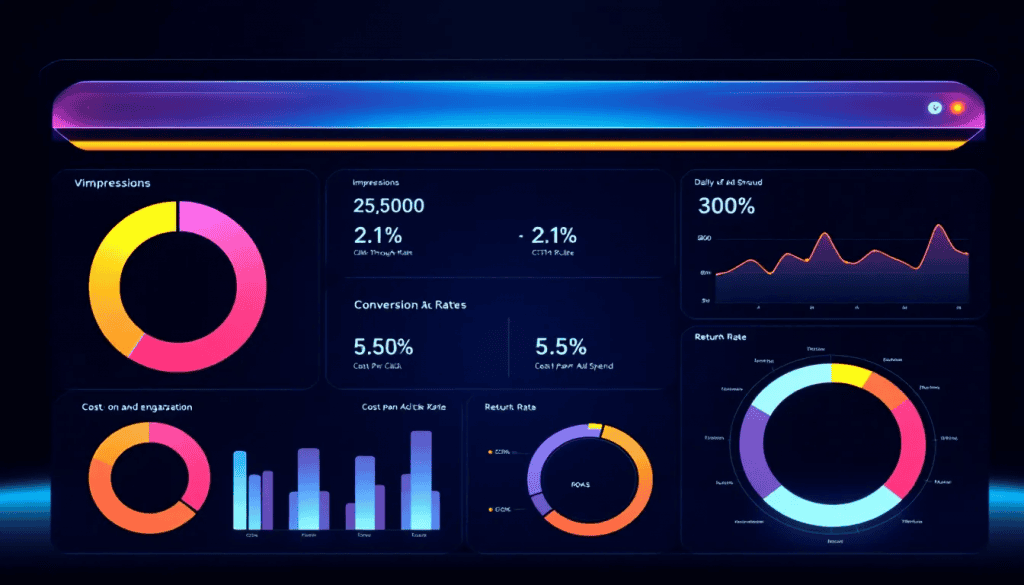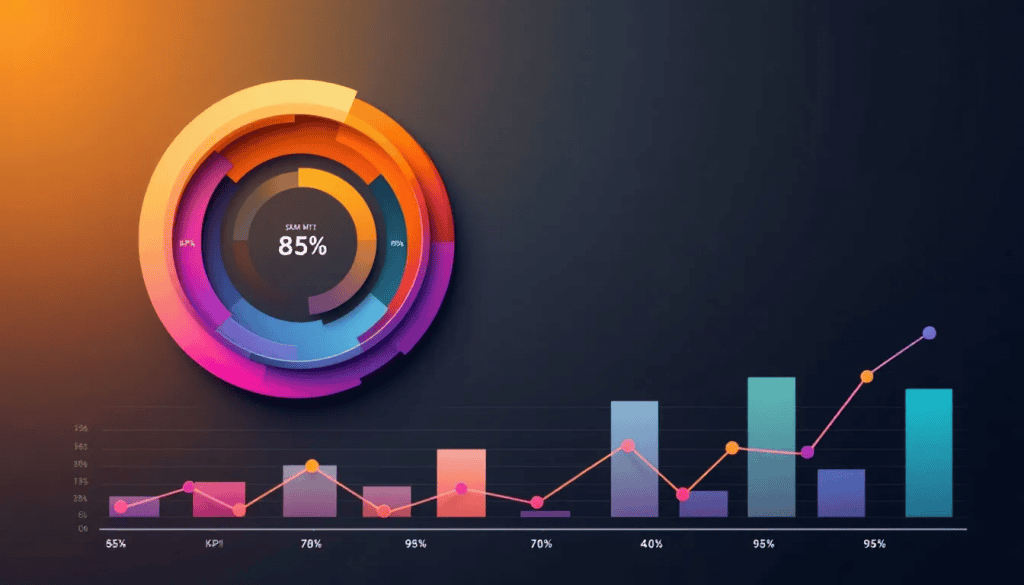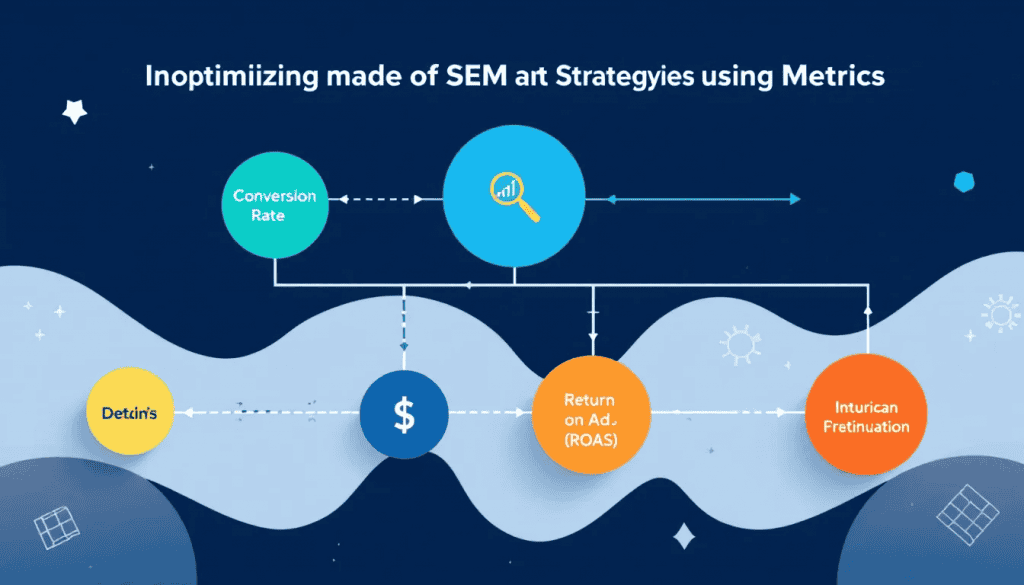Search engine marketing metrics help you measure and improve your campaign performance. Metrics like Click-Through Rate (CTR), Quality Score, and Conversion Rate (CVR) give insights into what works and what doesn’t. This article will guide you through the key SEM metrics and how to track and optimize them.
Essential SEM Metrics for Campaign Success

Monitoring essential SEM metrics is crucial for evaluating the effectiveness of your marketing initiatives. These indicators provide insights into how well your strategies are performing, identifying successful aspects and pinpointing areas that need improvement. Factors such as click-through rates (CTR), quality scores, and conversion rates play a pivotal role in determining the success of ad campaigns. Consistent tracking of these metrics ensures that advertisements meet their objectives effectively and help identify which campaigns are most profitable.
Key SEM metrics like CTR, Quality Score, and Conversion Rate (CVR) yield important information about user interaction with ads, relevance to consumer interests or queries, and overall campaign efficacy. Subsequent sections will Explore each metric’s importance while offering actionable advice on optimizing them for better performance.
Click-Through Rate (CTR)
The Click-Through Rate (CTR) is a critical metric in SEM campaigns that reflects the proportion of viewers who proceed to click on your advertisement after viewing it, showcasing the effectiveness of your ad copy. Achieving a high CTR not only denotes that you are reaching an interested audience, but also contributes favorably to improving your Quality Score. To enhance CTR, one must focus on creating compelling narratives within ads and ensure alignment between keywords and user intentions.
Achieving a robust CTR necessitates crafting relevant ad copy and targeting keywords proficiently. Leveraging platforms like Google Analytics enables marketers to monitor these parameters closely while gaining valuable insights into which advertisements connect best with their targeted demographic.
By optimizing for an elevated Click-Through Rate, advertisers can drive more pertinent traffic, leading ultimately to enhanced rates of conversion.
Quality Score
The metric known as Quality Score assesses the relevance and overall quality of your landing pages, ads, and keywords. Operating on a scale from 1 to 10, this score has an impact on both ad placement and the cost you incur for each click (CPC). Obtaining a higher Quality Score can help decrease advertising expenses while simultaneously boosting the visibility of your advertisement. The factors that influence Quality Score include how relevant your ad is expected to be to users, its predicted click-through rate (CTR), and what kind of experience visitors have upon arriving at your landing page.
To secure a superior Quality Score, it’s crucial to enhance not only the pertinence between advertisements and corresponding keywords, but also refine user experiences when they follow through from queries onto landing pages. Resources such as Google Search Console offer invaluable data which can guide improvements in these areas specifically tailored for search engines’ algorithms.
Consistently sustaining a lofty Quality Score facilitates more economical marketing efforts while garnering enhanced outcomes without having excessive costs.
Conversion Rate (CVR)
The conversion rate (CVR) is an essential metric indicating the proportion of users who take a desired action, such as purchasing or completing a form, after clicking on your advertisement. This key performance indicator helps to evaluate how well your ads convert interest into valuable outcomes. An impressive CVR indicates that the money spent on advertising is yielding fruitful results. A robust conversion rate usually ranges from 2% to 5%, reflecting commendable ad effectiveness.
To boost the CVR, it’s important to continually optimize both your ad copy and landing pages through testing and refinements. Factors like page load times, user interface design, and a compelling value proposition profoundly influence conversion rates. Concentrating efforts on these critical aspects can significantly improve user experiences and subsequently increase conversions derived from Search Engine Marketing (SEM) campaigns.
Cost Metrics in SEM

Managing SEM budgets effectively and securing campaign profitability hinge on the careful monitoring of cost metrics. Such metrics yield valuable insights into both expenditure and return on investment, allowing for refinement in areas to optimize costs and redistribute resources more efficiently. Employing strategies such as incorporating negative keywords can greatly diminish unwarranted ad spend, leading to enhanced budget effectiveness.
It’s imperative to keep track of key cost metrics like Cost Per Click (CPC), Cost Per Acquisition (CPA), and Return on Ad Spend (ROAS). These indicators offer distinct viewpoints regarding your financial outlay and its success rate. We will delve deeper into these essential cost metrics within subsequent subsections, examining their importance while also discussing how they can be best optimized for superior campaign performance.
Cost Per Click (CPC)
The Cost Per Click (CPC) reflects the fee incurred every time your advertisement is clicked. This value is dependent on the desirability and quality of your selected keywords. You can attain a reduced CPC by refining your ad relevance and keyword optimization, which will help in gauging how effectively you’re allocating funds to your campaigns.
To diminish the CPC, one may consider decreasing bid amounts, honing their strategies for keyword selection, and improving the pertinence of ads. Executing these measures could result in more judicious use of advertising budgets and heightened campaign effectiveness.
Platforms such as Google Ads provide comprehensive analyses regarding CPC metrics that enable informed decisions rooted in data.
Cost Per Acquisition (CPA)
The expense of acquiring a new customer is quantified by the Cost Per Acquisition (CPA) metric. It’s derived from dividing the sum invested in an ad campaign by the number of customers acquired. This essential indicator gauges how well your advertising efforts are at converting prospects into customers, playing a pivotal role in evaluating their success.
For effective CPA management, it is crucial to refine your ad campaigns for attracting better traffic that leads to conversions. Gaining insights into and managing your CPA empowers you to confirm that marketing endeavors are yielding profitable results while maintaining sustainability over time.
Return on Ad Spend (ROAS)
The Return on Ad Spend (ROAS) is a key metric that calculates the amount of revenue generated for every dollar invested in advertising. It’s an essential indicator for gauging the success and profitability of ad campaigns by taking the aggregate conversion value and dividing it by total ad spend. By keeping track of ROAS, you can make more educated decisions about where to allocate your advertising budget and how to refine campaign strategies.
Incorporating Customer Lifetime Value (CLV) into consideration alongside ROAS provides a more complete understanding of advertisement expenditure as well as its enduring effects. Emphasizing both metrics allows you to better adjust your spending strategy, leading to improvements in your Search Engine Marketing (SEM) campaigns’ efficiency over time.
Visibility and Engagement Metrics

Metrics related to engagement and visibility, such as click-through rates and search impression share, play a vital role in gauging the performance of your ads concerning user interaction and their presence in search results. The effectiveness of campaigns is bolstered by higher click-through rates and enhanced impressions from searches. Incorporating negative keywords improves the pertinence and efficiency of ads by eliminating traffic that does not meet qualification criteria.
Key indicators for evaluating ad performance include Impression Share, Average Position, and Bounce Rate. These metrics shed light on the extent to which your advertisements are seen, their ranking within search results, and how effectively they retain user interest. Each metric will be examined more closely in subsequent subsections to provide an in-depth understanding of their significance.
Impression Share
Impression Share is an essential metric indicating the visibility level of your ads in relation to all possible impressions they could receive. It calculates what fraction of impressions were actually served to your ads from the eligible pool, and a substantial impression share signifies robust ad presence which can lead to increased conversion possibilities.
To augment impression share, one may consider amplifying their budget or refining their ad rank. Concentrating on these elements can bolster the prominence of your advertisements and amplify the extent of coverage achieved by your advertising efforts.
Average Position
The metric known as Average Position is crucial in determining the ranking of your ads on search engine results pages, subsequently affecting visibility and click-through rates. Ads that appear in superior positions tend to garner more clicks, thereby underlining the importance of this measure for enhancing ad effectiveness. A lofty average position equates to heightened exposure and improved campaign success.
To elevate your ad’s average position on a search engine, it’s imperative to enhance Quality Score while also raising bids for keywords that deliver strong performance. These tactics can foster better click-through rates which may ultimately lead to an increase in conversions.
Bounce Rate
The bounce rate is an indicator of the proportion of users that exit a landing page without any form of engagement. A reduced bounce rate suggests that the content on the page is more captivating and there’s an increased likelihood for conversions to occur. The speed at which a page loads, along with its user interface design and how relevant its content is, are all critical in decreasing bounce rates.
Employing A/B testing can assist in pinpointing the designs of landing pages that result in decreased bounce rates. When you optimize your landing pages to boost user interaction, it has a substantial positive impact on the efficacy of SEM campaigns.
Advanced SEM Metrics for In-Depth Analysis

Metrics that delve deep into the nuances of Search Engine Marketing (SEM) are pivotal for enhancing campaign performance and informing strategic choices. Crucial for polishing SEM tactics, these advanced metrics help optimize the effectiveness of campaigns by integrating data such as Return on Ad Spend (ROAS) with insights about Customer Lifetime Value (CLV), offering a holistic perspective on advertising expenditure and its profitability.
To get an in-depth grasp of your SEM endeavors, it is crucial to monitor key sophisticated metrics like Customer Lifetime Value (CLV), Wasted Spend, and Search Impression Share Lost. By tracking these indicators, you gain valuable insight into how well your efforts are faring while pinpointing specific areas needing refinement.
Customer Lifetime Value (CLV)
The total expected revenue from a customer throughout their relationship with a company is encapsulated in the Customer Lifetime Value (CLV). It provides critical insight into the amount to be invested in new customer acquisition and identifies which product categories yield the highest profitability. The average purchase value, number of purchases made annually, and duration of an average customer’s association with the business are factors used to determine CLV.
Informed decision-making regarding budget distribution and crafting marketing strategies benefit greatly from understanding CLV. By dividing customers according to their SEM source, it becomes possible to accurately assess how different marketing channels contribute to varying levels of Customer Lifetime Value.
Wasted Spend
Clicks that do not result in conversions signify wasted spend, shining a light on segments of your ad campaign where the investment fails to produce desired outcomes. The integration of negative keywords can curtail this inefficiency and enhance the effectiveness of your ads.
By perpetually honing your keyword strategy within search marketing, you ensure that paid ads are displayed to an audience most relevant to them. This method aids in trimming unnecessary ads and elevates the overall performance of your advertising efforts.
Search Impression Share Lost
The metric Search Impression Share Lost quantifies the proportion of instances in which ads did not appear because of limited budgets or a deficient ad rank. It illuminates potential opportunities that were not seized and suggests areas where enhancement is possible. To mitigate the loss of impression share, it’s advisable to contemplate elevating your budget or augmenting your ad rank by refining both your Quality Score and click-through rates.
Concentrating on these elements can enable you to regain missed impressions and bolster the prominence of your search engine marketing initiatives.
Tools for Tracking SEM Metrics
Essential for overseeing and improving the effectiveness of campaigns, instruments designed to monitor SEM metrics provide extensive search marketing data that covers numerous facets of SEM initiatives. This allows for well-informed choices and strategic modifications. A well-crafted SEM report highlights how both organic strategies and paid tactics collectively influence the increase in revenue.
Among the crucial tools utilized for tracking SEM metrics are Google Analytics, Google Ads, and SEMrush. Each tool comes equipped with distinctive features that assist in evaluating and enhancing the performance of search marketing efforts.
Google Analytics
Digital marketers can harness the capabilities of Google Analytics to monitor and evaluate the success of their SEM campaigns. It offers an extensive range of data regarding site traffic, detailing not only how users arrive at your website, but also their subsequent activities. This information is vital in refining marketing strategies by providing insights into user behavior.
Google Analytics delivers nuanced metrics about visitor interaction, from pages viewed and duration spent on-site to distinct actions executed by visitors. These analytics empower digital marketers with actionable intelligence for the iterative enhancement of ad campaigns and landing page performance—key components that should resonate with a holistic digital marketing strategy.
Google Ads
Google is the most popular search engine. Ads provides comprehensive performance analytics, encompassing metrics such as click-through rates and cost-per-click. These insights are critical for assessing the effectiveness of advertisements and pinpointing areas that require enhancement. Utilizing data from Google. Ads facilitates the fine-tuning of ad copy, bid adjustments, and keyword strategy optimization to boost overall campaign results with Google AdWords.
The integration between Google Ads and tools like Google Analytics, Google Search Console, and your personal google ads account forms a robust framework for overseeing search engine marketing (SEM) initiatives. This interconnected setup grants access to vital information needed to make educated decisions that elevate marketing strategies.
SEMrush
SEMrush delivers potent capabilities for keyword research, allowing users to pinpoint pertinent keywords and monitor their rankings. As a critical instrument for boosting SEM initiatives, this tool simplifies the process of researching keywords and tracking their effectiveness. It also offers a glimpse into competitors’ keyword bids and advertisement configurations, giving users an advantage over rivals.
SEMrush presents an extensive analysis of competitors that aids in recognizing primary rivals and deciphering their tactics. Such insights are vital in honing your SEM campaigns to guarantee that your advertisements are consistently fine-tuned for the greatest possible influence.
Optimizing SEM Strategies Using Metrics

nhancing the effectiveness of search engine marketing campaigns necessitates decisions informed by data. Assessing key performance indicators like return on advertising spend (ROAS), cost per click (CPC), and click-through rate (CTR) can pinpoint where adjustments are needed to bolster campaign results. Utilizing sophisticated metrics from SEM offers vital knowledge that steers strategic choices, aiming to optimize investment returns.
Central to optimization efforts are practices such as bid modification, polishing landing pages and ads, implementing negative keywords in your strategy, and harnessing the capabilities of paid search marketing. These approaches each contribute significantly to sharpening your search marketing efforts, guaranteeing optimal outcomes for your campaigns in the competitive landscape of engine marketing.
Adjusting Bids Based on Performance
It’s essential to regularly modify keyword bids based on their performance indicators. By raising the stakes for keywords that deliver strong results, you enhance the potential return on investment and secure premier positions for your ads. This approach efficiently distributes your advertising budget by concentrating resources on those keywords which yield the greatest number of conversions and income.
To apply this tactic effectively, consistently analyze data related to how well each keyword performs and make bid adjustments where necessary. Persistent fine-tuning will lead to ad campaigns that are both competitive in nature and economical in cost, ultimately yielding improved outcomes as time progresses.
Improving Ad Copy and Landing Pages
Enhance user engagement by revising ad copy, informed by the analysis of click-through rates and conversion metrics. Determining which ads perform best through CTR studies allows for modifications rooted in data insights. Upgrading ad copy not only elevates click-through rates, but also augments the relevance of ads, propelling overall campaign efficacy.
Crucial to lowering bounce rates and amplifying conversions is the optimization of landing pages. To ensure a fluid user experience conducive to higher conversion numbers, focus on accelerating page load times, refining the user interface, and bolstering the value proposition presented on each landing page.
Leveraging Negative Keywords
In SEM campaigns, incorporating negative keywords is crucial as they prevent ads from being displayed in response to certain search queries. This serves as a mechanism to refine the traffic that views the advertisements, guaranteeing that only an audience with relevance sees them. Utilizing negative keywords boosts ad pertinence and curtails unnecessary expenditures by refining advertising precision.
By methodically adding negative keywords into your strategy, you hinder your ads from appearing during searches that don’t lead to conversions, which enhances the effectiveness of your SEM campaign. It’s important to periodically reassess and adjust your list of negative keywords so it remains consistent with both the objectives of your campaign and targeting specifics for your intended audience.
Comprehensive Summary of Search Engine Marketing Metrics
In the realm of digital marketing, grasping and monitoring key SEM metrics is crucial for a thriving digital marketing strategy. Metrics such as Click-Through Rate (CTR) and Quality Score, along with more complex ones like Customer Lifetime Value (CLV) and Return on Ad Spend (ROAS), each offer distinct insights into how your campaigns are performing. By using tools including Google Analytics, Google Ads, and SEMrush to accumulate extensive data, you can refine your Search Engine Marketing endeavors effectively. Constant vigilance and enhancement of these metrics will guarantee that your campaigns remain congruent with your strategic objectives in marketing while yielding optimal outcomes. If you’re eager to enhance the performance of your SEM initiatives significantly? It’s time to initiate tracking those key metrics and fine tune them without delay!
Frequently Asked Questions
What is Click-Through Rate (CTR) and why is it important?
Click-Through Rate (CTR) shows how many people click on your ad after seeing it, and it’s crucial because a higher CTR means your ad resonates well with your audience, boosting your Quality Score and reducing costs.
How can I improve my Quality Score?
Concentrate on enhancing the relevance of both your keywords and ads, as well as improving user experience on your landing pages to increase your Quality Score.
Leverage tools such as Google Search Console to gain essential insights that can help steer the enhancements you make.
What is the significance of Conversion Rate (CVR)?
The significance of conversion rate (CVR) lies in its ability to show how effectively your ads turn clicks into desired actions. A high CVR means you’re getting good returns on your ad spend, which is essential for evaluating ad performance.
How do I minimize wasted spend in my SEM campaigns?
To cut down on wasted spend in your SEM campaigns, implement negative keywords to filter out irrelevant searches, and regularly fine-tune your keyword strategy to target the most pertinent audience.
This way, your budget goes further where it counts!
What tools are best for tracking SEM metrics?
To effectively track SEM metrics, Google Analytics, Google Ads, and SEMrush are your best bets. They offer detailed insights that can help you optimize your campaigns and improve performance.
